Research Report: Organisational Culture and Job Satisfaction at Hilton
VerifiedAdded on 2023/06/15
|15
|4006
|163
Report
AI Summary
This report investigates the impact of organisational culture on job satisfaction, focusing on Hilton Hotels in the United Kingdom. It begins by defining organisational culture and its relationship with leadership behavior and job satisfaction. The problem statement identifies ineffective organisational culture as a cause of employee absenteeism and turnover. The research aims to explore the concept of organisational culture, understand job satisfaction, analyse their relationship within Hilton Hotels, and suggest strategies for improvement. The literature review covers definitions of organisational culture, the importance of a positive work culture, and the impact of organisational culture on job satisfaction, highlighting both positive and negative influences. Strategies for improving organisational culture, such as revisiting core values, evaluating current culture, tracking progress, creating opportunities, and prioritizing transparency, are also discussed.
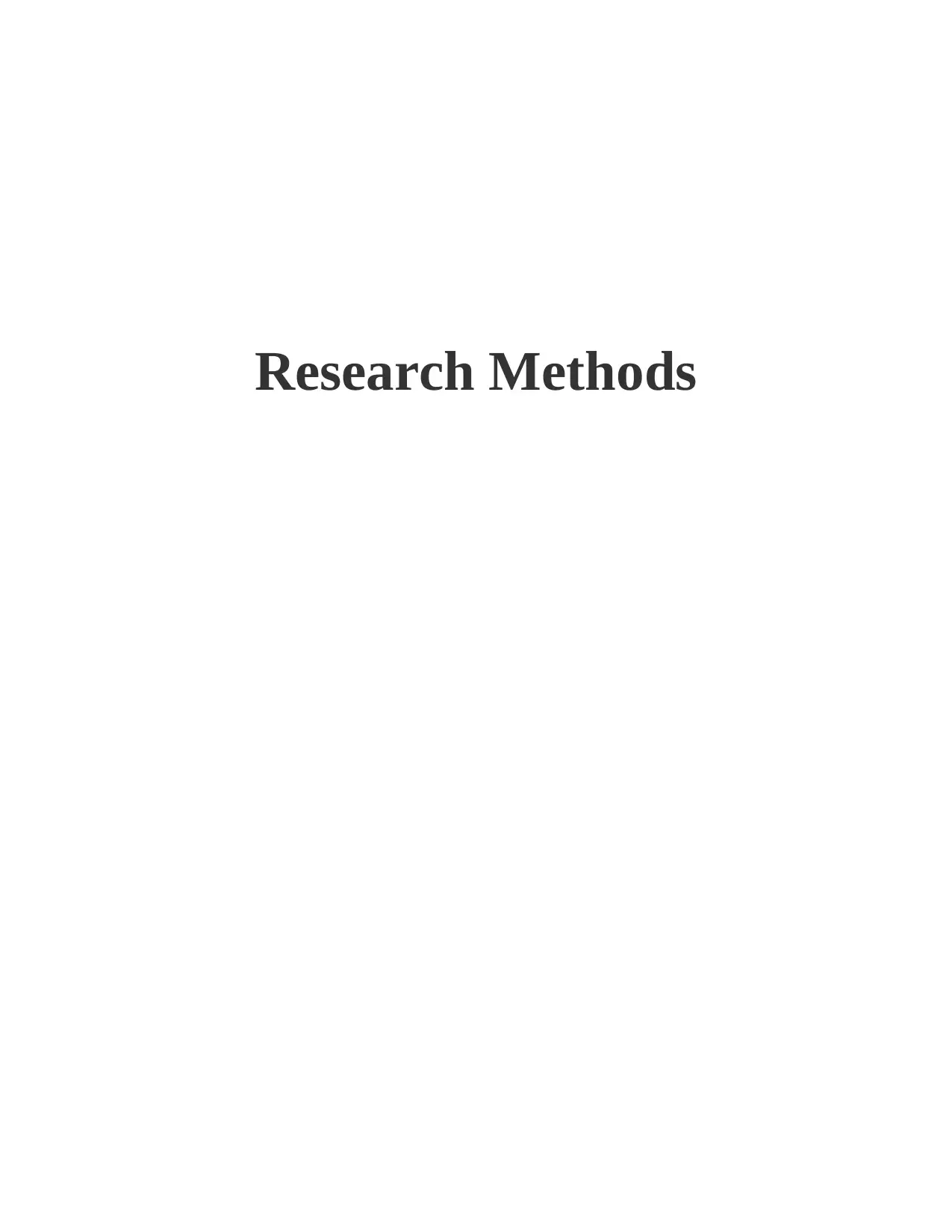
Research Methods
Paraphrase This Document
Need a fresh take? Get an instant paraphrase of this document with our AI Paraphraser
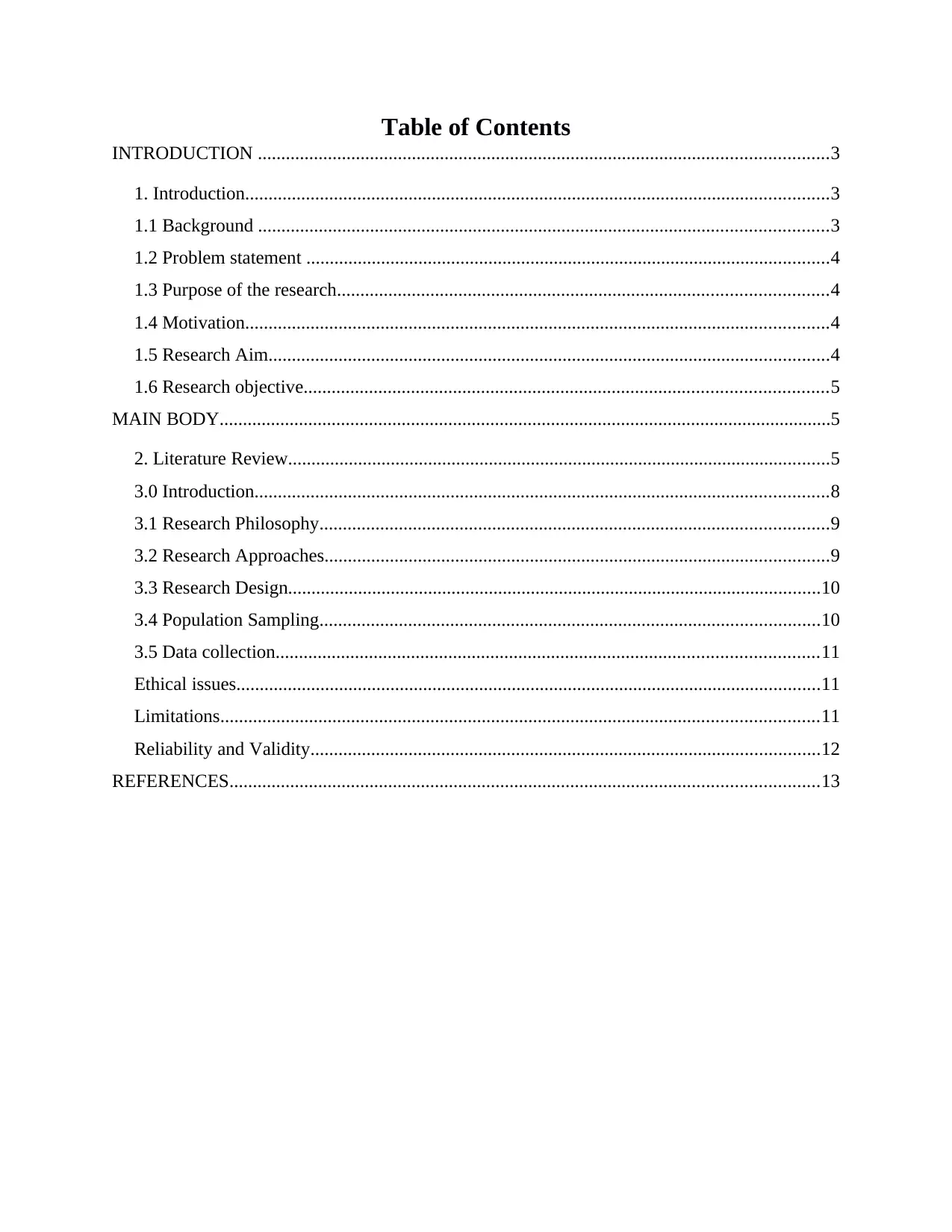
Table of Contents
INTRODUCTION ..........................................................................................................................3
1. Introduction.............................................................................................................................3
1.1 Background ..........................................................................................................................3
1.2 Problem statement ................................................................................................................4
1.3 Purpose of the research.........................................................................................................4
1.4 Motivation.............................................................................................................................4
1.5 Research Aim........................................................................................................................4
1.6 Research objective................................................................................................................5
MAIN BODY...................................................................................................................................5
2. Literature Review....................................................................................................................5
3.0 Introduction...........................................................................................................................8
3.1 Research Philosophy.............................................................................................................9
3.2 Research Approaches............................................................................................................9
3.3 Research Design..................................................................................................................10
3.4 Population Sampling...........................................................................................................10
3.5 Data collection....................................................................................................................11
Ethical issues.............................................................................................................................11
Limitations................................................................................................................................11
Reliability and Validity.............................................................................................................12
REFERENCES..............................................................................................................................13
INTRODUCTION ..........................................................................................................................3
1. Introduction.............................................................................................................................3
1.1 Background ..........................................................................................................................3
1.2 Problem statement ................................................................................................................4
1.3 Purpose of the research.........................................................................................................4
1.4 Motivation.............................................................................................................................4
1.5 Research Aim........................................................................................................................4
1.6 Research objective................................................................................................................5
MAIN BODY...................................................................................................................................5
2. Literature Review....................................................................................................................5
3.0 Introduction...........................................................................................................................8
3.1 Research Philosophy.............................................................................................................9
3.2 Research Approaches............................................................................................................9
3.3 Research Design..................................................................................................................10
3.4 Population Sampling...........................................................................................................10
3.5 Data collection....................................................................................................................11
Ethical issues.............................................................................................................................11
Limitations................................................................................................................................11
Reliability and Validity.............................................................................................................12
REFERENCES..............................................................................................................................13
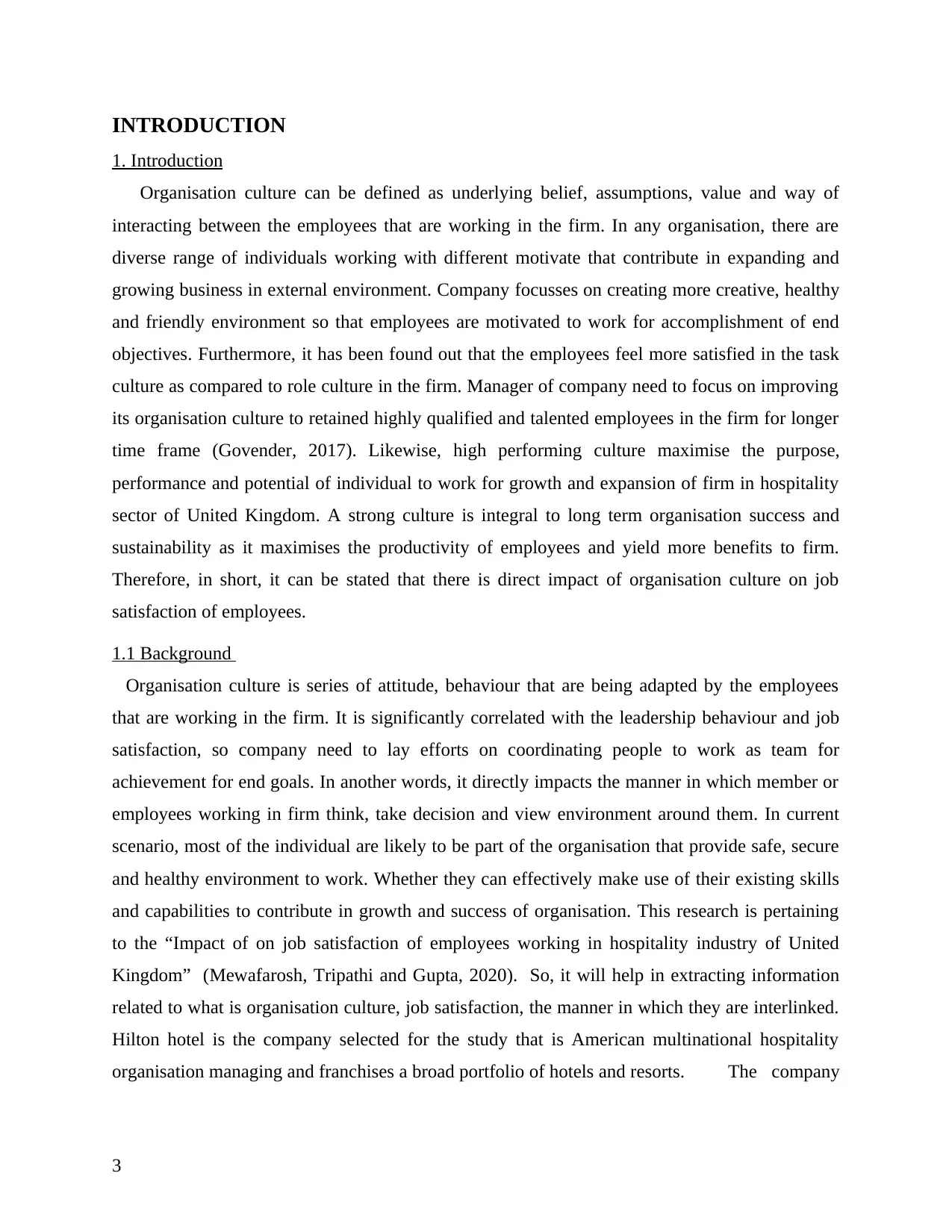
INTRODUCTION
1. Introduction
Organisation culture can be defined as underlying belief, assumptions, value and way of
interacting between the employees that are working in the firm. In any organisation, there are
diverse range of individuals working with different motivate that contribute in expanding and
growing business in external environment. Company focusses on creating more creative, healthy
and friendly environment so that employees are motivated to work for accomplishment of end
objectives. Furthermore, it has been found out that the employees feel more satisfied in the task
culture as compared to role culture in the firm. Manager of company need to focus on improving
its organisation culture to retained highly qualified and talented employees in the firm for longer
time frame (Govender, 2017). Likewise, high performing culture maximise the purpose,
performance and potential of individual to work for growth and expansion of firm in hospitality
sector of United Kingdom. A strong culture is integral to long term organisation success and
sustainability as it maximises the productivity of employees and yield more benefits to firm.
Therefore, in short, it can be stated that there is direct impact of organisation culture on job
satisfaction of employees.
1.1 Background
Organisation culture is series of attitude, behaviour that are being adapted by the employees
that are working in the firm. It is significantly correlated with the leadership behaviour and job
satisfaction, so company need to lay efforts on coordinating people to work as team for
achievement for end goals. In another words, it directly impacts the manner in which member or
employees working in firm think, take decision and view environment around them. In current
scenario, most of the individual are likely to be part of the organisation that provide safe, secure
and healthy environment to work. Whether they can effectively make use of their existing skills
and capabilities to contribute in growth and success of organisation. This research is pertaining
to the “Impact of on job satisfaction of employees working in hospitality industry of United
Kingdom” (Mewafarosh, Tripathi and Gupta, 2020). So, it will help in extracting information
related to what is organisation culture, job satisfaction, the manner in which they are interlinked.
Hilton hotel is the company selected for the study that is American multinational hospitality
organisation managing and franchises a broad portfolio of hotels and resorts. The company
3
1. Introduction
Organisation culture can be defined as underlying belief, assumptions, value and way of
interacting between the employees that are working in the firm. In any organisation, there are
diverse range of individuals working with different motivate that contribute in expanding and
growing business in external environment. Company focusses on creating more creative, healthy
and friendly environment so that employees are motivated to work for accomplishment of end
objectives. Furthermore, it has been found out that the employees feel more satisfied in the task
culture as compared to role culture in the firm. Manager of company need to focus on improving
its organisation culture to retained highly qualified and talented employees in the firm for longer
time frame (Govender, 2017). Likewise, high performing culture maximise the purpose,
performance and potential of individual to work for growth and expansion of firm in hospitality
sector of United Kingdom. A strong culture is integral to long term organisation success and
sustainability as it maximises the productivity of employees and yield more benefits to firm.
Therefore, in short, it can be stated that there is direct impact of organisation culture on job
satisfaction of employees.
1.1 Background
Organisation culture is series of attitude, behaviour that are being adapted by the employees
that are working in the firm. It is significantly correlated with the leadership behaviour and job
satisfaction, so company need to lay efforts on coordinating people to work as team for
achievement for end goals. In another words, it directly impacts the manner in which member or
employees working in firm think, take decision and view environment around them. In current
scenario, most of the individual are likely to be part of the organisation that provide safe, secure
and healthy environment to work. Whether they can effectively make use of their existing skills
and capabilities to contribute in growth and success of organisation. This research is pertaining
to the “Impact of on job satisfaction of employees working in hospitality industry of United
Kingdom” (Mewafarosh, Tripathi and Gupta, 2020). So, it will help in extracting information
related to what is organisation culture, job satisfaction, the manner in which they are interlinked.
Hilton hotel is the company selected for the study that is American multinational hospitality
organisation managing and franchises a broad portfolio of hotels and resorts. The company
3
⊘ This is a preview!⊘
Do you want full access?
Subscribe today to unlock all pages.

Trusted by 1+ million students worldwide
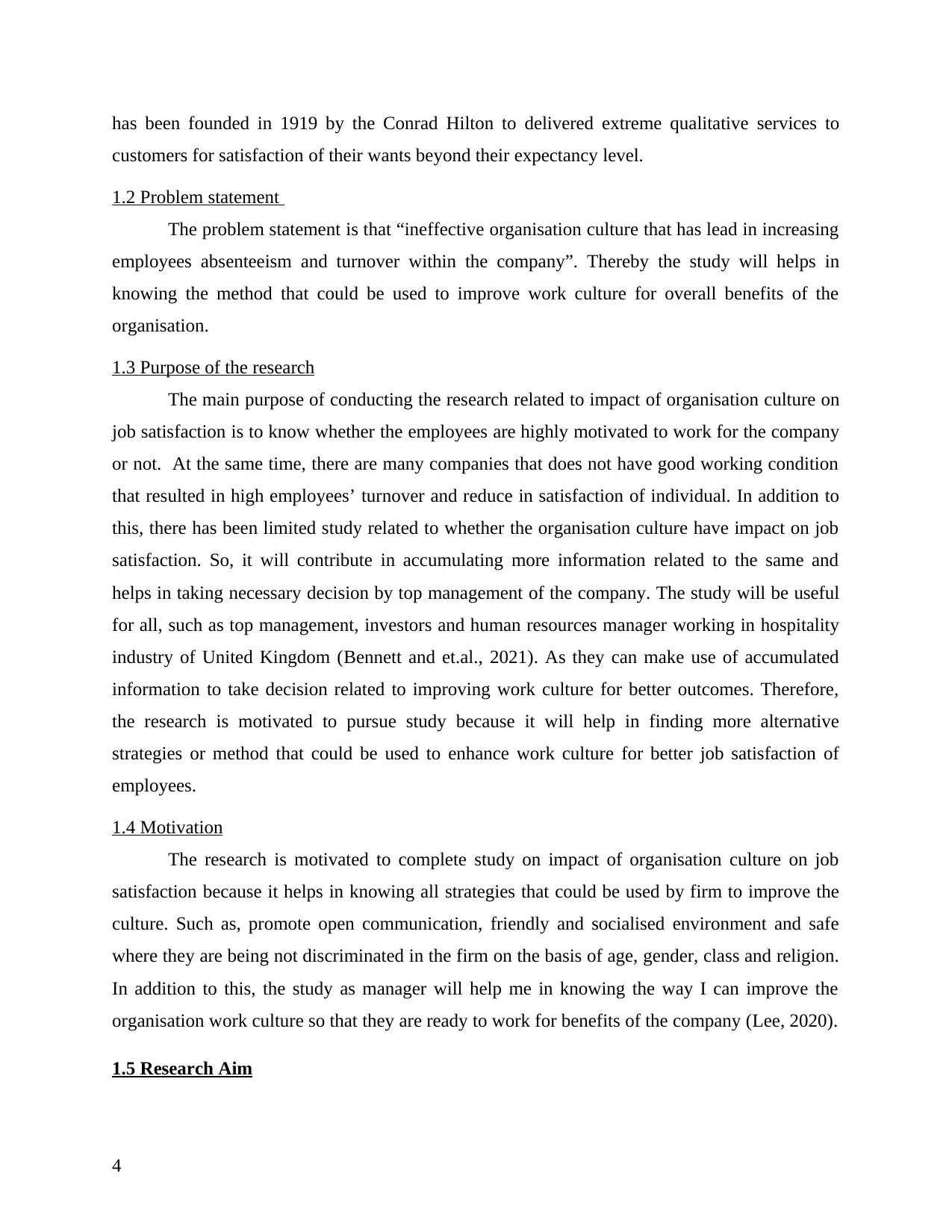
has been founded in 1919 by the Conrad Hilton to delivered extreme qualitative services to
customers for satisfaction of their wants beyond their expectancy level.
1.2 Problem statement
The problem statement is that “ineffective organisation culture that has lead in increasing
employees absenteeism and turnover within the company”. Thereby the study will helps in
knowing the method that could be used to improve work culture for overall benefits of the
organisation.
1.3 Purpose of the research
The main purpose of conducting the research related to impact of organisation culture on
job satisfaction is to know whether the employees are highly motivated to work for the company
or not. At the same time, there are many companies that does not have good working condition
that resulted in high employees’ turnover and reduce in satisfaction of individual. In addition to
this, there has been limited study related to whether the organisation culture have impact on job
satisfaction. So, it will contribute in accumulating more information related to the same and
helps in taking necessary decision by top management of the company. The study will be useful
for all, such as top management, investors and human resources manager working in hospitality
industry of United Kingdom (Bennett and et.al., 2021). As they can make use of accumulated
information to take decision related to improving work culture for better outcomes. Therefore,
the research is motivated to pursue study because it will help in finding more alternative
strategies or method that could be used to enhance work culture for better job satisfaction of
employees.
1.4 Motivation
The research is motivated to complete study on impact of organisation culture on job
satisfaction because it helps in knowing all strategies that could be used by firm to improve the
culture. Such as, promote open communication, friendly and socialised environment and safe
where they are being not discriminated in the firm on the basis of age, gender, class and religion.
In addition to this, the study as manager will help me in knowing the way I can improve the
organisation work culture so that they are ready to work for benefits of the company (Lee, 2020).
1.5 Research Aim
4
customers for satisfaction of their wants beyond their expectancy level.
1.2 Problem statement
The problem statement is that “ineffective organisation culture that has lead in increasing
employees absenteeism and turnover within the company”. Thereby the study will helps in
knowing the method that could be used to improve work culture for overall benefits of the
organisation.
1.3 Purpose of the research
The main purpose of conducting the research related to impact of organisation culture on
job satisfaction is to know whether the employees are highly motivated to work for the company
or not. At the same time, there are many companies that does not have good working condition
that resulted in high employees’ turnover and reduce in satisfaction of individual. In addition to
this, there has been limited study related to whether the organisation culture have impact on job
satisfaction. So, it will contribute in accumulating more information related to the same and
helps in taking necessary decision by top management of the company. The study will be useful
for all, such as top management, investors and human resources manager working in hospitality
industry of United Kingdom (Bennett and et.al., 2021). As they can make use of accumulated
information to take decision related to improving work culture for better outcomes. Therefore,
the research is motivated to pursue study because it will help in finding more alternative
strategies or method that could be used to enhance work culture for better job satisfaction of
employees.
1.4 Motivation
The research is motivated to complete study on impact of organisation culture on job
satisfaction because it helps in knowing all strategies that could be used by firm to improve the
culture. Such as, promote open communication, friendly and socialised environment and safe
where they are being not discriminated in the firm on the basis of age, gender, class and religion.
In addition to this, the study as manager will help me in knowing the way I can improve the
organisation work culture so that they are ready to work for benefits of the company (Lee, 2020).
1.5 Research Aim
4
Paraphrase This Document
Need a fresh take? Get an instant paraphrase of this document with our AI Paraphraser
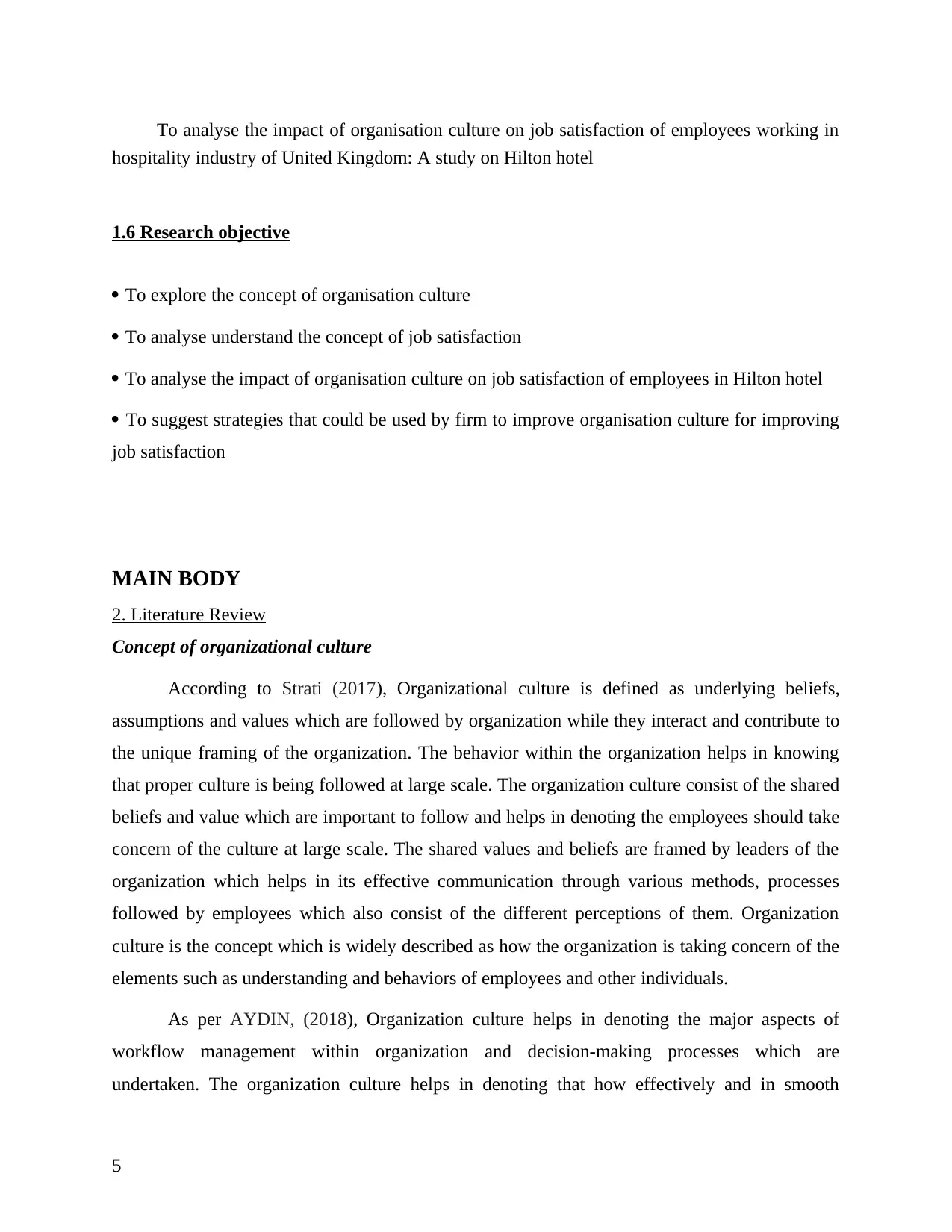
To analyse the impact of organisation culture on job satisfaction of employees working in
hospitality industry of United Kingdom: A study on Hilton hotel
1.6 Research objective
· To explore the concept of organisation culture
· To analyse understand the concept of job satisfaction
· To analyse the impact of organisation culture on job satisfaction of employees in Hilton hotel
· To suggest strategies that could be used by firm to improve organisation culture for improving
job satisfaction
MAIN BODY
2. Literature Review
Concept of organizational culture
According to Strati (2017), Organizational culture is defined as underlying beliefs,
assumptions and values which are followed by organization while they interact and contribute to
the unique framing of the organization. The behavior within the organization helps in knowing
that proper culture is being followed at large scale. The organization culture consist of the shared
beliefs and value which are important to follow and helps in denoting the employees should take
concern of the culture at large scale. The shared values and beliefs are framed by leaders of the
organization which helps in its effective communication through various methods, processes
followed by employees which also consist of the different perceptions of them. Organization
culture is the concept which is widely described as how the organization is taking concern of the
elements such as understanding and behaviors of employees and other individuals.
As per AYDIN, (2018), Organization culture helps in denoting the major aspects of
workflow management within organization and decision-making processes which are
undertaken. The organization culture helps in denoting that how effectively and in smooth
5
hospitality industry of United Kingdom: A study on Hilton hotel
1.6 Research objective
· To explore the concept of organisation culture
· To analyse understand the concept of job satisfaction
· To analyse the impact of organisation culture on job satisfaction of employees in Hilton hotel
· To suggest strategies that could be used by firm to improve organisation culture for improving
job satisfaction
MAIN BODY
2. Literature Review
Concept of organizational culture
According to Strati (2017), Organizational culture is defined as underlying beliefs,
assumptions and values which are followed by organization while they interact and contribute to
the unique framing of the organization. The behavior within the organization helps in knowing
that proper culture is being followed at large scale. The organization culture consist of the shared
beliefs and value which are important to follow and helps in denoting the employees should take
concern of the culture at large scale. The shared values and beliefs are framed by leaders of the
organization which helps in its effective communication through various methods, processes
followed by employees which also consist of the different perceptions of them. Organization
culture is the concept which is widely described as how the organization is taking concern of the
elements such as understanding and behaviors of employees and other individuals.
As per AYDIN, (2018), Organization culture helps in denoting the major aspects of
workflow management within organization and decision-making processes which are
undertaken. The organization culture helps in denoting that how effectively and in smooth
5
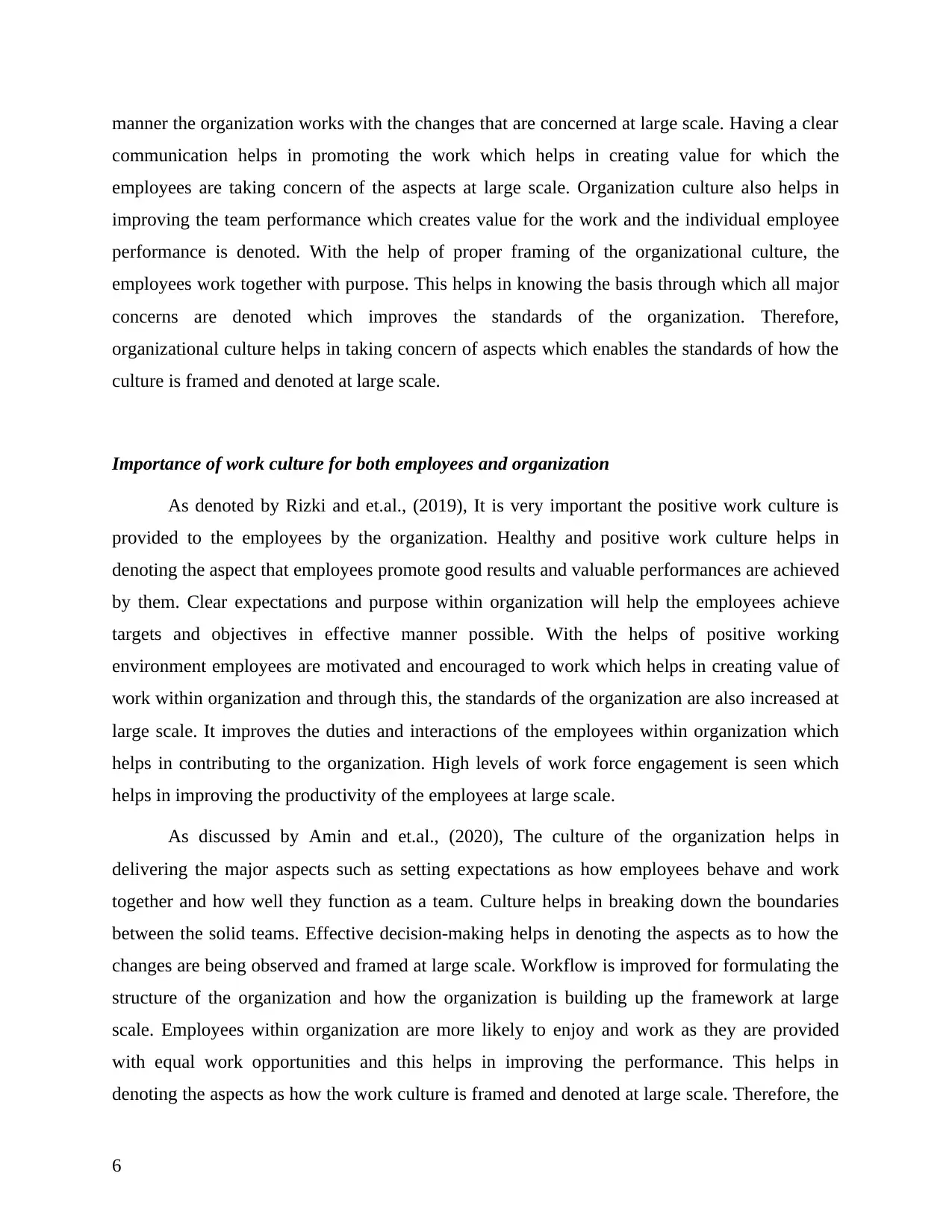
manner the organization works with the changes that are concerned at large scale. Having a clear
communication helps in promoting the work which helps in creating value for which the
employees are taking concern of the aspects at large scale. Organization culture also helps in
improving the team performance which creates value for the work and the individual employee
performance is denoted. With the help of proper framing of the organizational culture, the
employees work together with purpose. This helps in knowing the basis through which all major
concerns are denoted which improves the standards of the organization. Therefore,
organizational culture helps in taking concern of aspects which enables the standards of how the
culture is framed and denoted at large scale.
Importance of work culture for both employees and organization
As denoted by Rizki and et.al., (2019), It is very important the positive work culture is
provided to the employees by the organization. Healthy and positive work culture helps in
denoting the aspect that employees promote good results and valuable performances are achieved
by them. Clear expectations and purpose within organization will help the employees achieve
targets and objectives in effective manner possible. With the helps of positive working
environment employees are motivated and encouraged to work which helps in creating value of
work within organization and through this, the standards of the organization are also increased at
large scale. It improves the duties and interactions of the employees within organization which
helps in contributing to the organization. High levels of work force engagement is seen which
helps in improving the productivity of the employees at large scale.
As discussed by Amin and et.al., (2020), The culture of the organization helps in
delivering the major aspects such as setting expectations as how employees behave and work
together and how well they function as a team. Culture helps in breaking down the boundaries
between the solid teams. Effective decision-making helps in denoting the aspects as to how the
changes are being observed and framed at large scale. Workflow is improved for formulating the
structure of the organization and how the organization is building up the framework at large
scale. Employees within organization are more likely to enjoy and work as they are provided
with equal work opportunities and this helps in improving the performance. This helps in
denoting the aspects as how the work culture is framed and denoted at large scale. Therefore, the
6
communication helps in promoting the work which helps in creating value for which the
employees are taking concern of the aspects at large scale. Organization culture also helps in
improving the team performance which creates value for the work and the individual employee
performance is denoted. With the help of proper framing of the organizational culture, the
employees work together with purpose. This helps in knowing the basis through which all major
concerns are denoted which improves the standards of the organization. Therefore,
organizational culture helps in taking concern of aspects which enables the standards of how the
culture is framed and denoted at large scale.
Importance of work culture for both employees and organization
As denoted by Rizki and et.al., (2019), It is very important the positive work culture is
provided to the employees by the organization. Healthy and positive work culture helps in
denoting the aspect that employees promote good results and valuable performances are achieved
by them. Clear expectations and purpose within organization will help the employees achieve
targets and objectives in effective manner possible. With the helps of positive working
environment employees are motivated and encouraged to work which helps in creating value of
work within organization and through this, the standards of the organization are also increased at
large scale. It improves the duties and interactions of the employees within organization which
helps in contributing to the organization. High levels of work force engagement is seen which
helps in improving the productivity of the employees at large scale.
As discussed by Amin and et.al., (2020), The culture of the organization helps in
delivering the major aspects such as setting expectations as how employees behave and work
together and how well they function as a team. Culture helps in breaking down the boundaries
between the solid teams. Effective decision-making helps in denoting the aspects as to how the
changes are being observed and framed at large scale. Workflow is improved for formulating the
structure of the organization and how the organization is building up the framework at large
scale. Employees within organization are more likely to enjoy and work as they are provided
with equal work opportunities and this helps in improving the performance. This helps in
denoting the aspects as how the work culture is framed and denoted at large scale. Therefore, the
6
⊘ This is a preview!⊘
Do you want full access?
Subscribe today to unlock all pages.

Trusted by 1+ million students worldwide
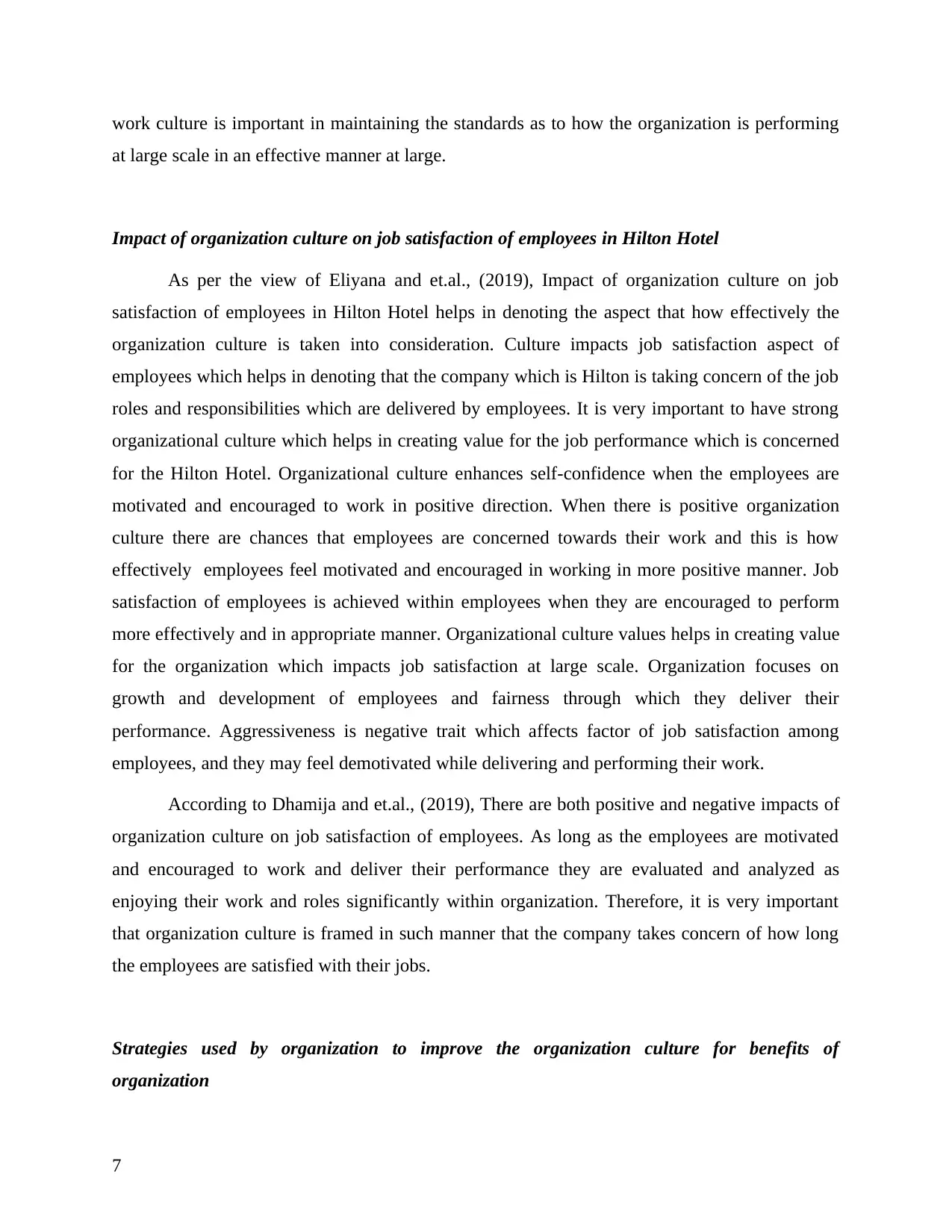
work culture is important in maintaining the standards as to how the organization is performing
at large scale in an effective manner at large.
Impact of organization culture on job satisfaction of employees in Hilton Hotel
As per the view of Eliyana and et.al., (2019), Impact of organization culture on job
satisfaction of employees in Hilton Hotel helps in denoting the aspect that how effectively the
organization culture is taken into consideration. Culture impacts job satisfaction aspect of
employees which helps in denoting that the company which is Hilton is taking concern of the job
roles and responsibilities which are delivered by employees. It is very important to have strong
organizational culture which helps in creating value for the job performance which is concerned
for the Hilton Hotel. Organizational culture enhances self-confidence when the employees are
motivated and encouraged to work in positive direction. When there is positive organization
culture there are chances that employees are concerned towards their work and this is how
effectively employees feel motivated and encouraged in working in more positive manner. Job
satisfaction of employees is achieved within employees when they are encouraged to perform
more effectively and in appropriate manner. Organizational culture values helps in creating value
for the organization which impacts job satisfaction at large scale. Organization focuses on
growth and development of employees and fairness through which they deliver their
performance. Aggressiveness is negative trait which affects factor of job satisfaction among
employees, and they may feel demotivated while delivering and performing their work.
According to Dhamija and et.al., (2019), There are both positive and negative impacts of
organization culture on job satisfaction of employees. As long as the employees are motivated
and encouraged to work and deliver their performance they are evaluated and analyzed as
enjoying their work and roles significantly within organization. Therefore, it is very important
that organization culture is framed in such manner that the company takes concern of how long
the employees are satisfied with their jobs.
Strategies used by organization to improve the organization culture for benefits of
organization
7
at large scale in an effective manner at large.
Impact of organization culture on job satisfaction of employees in Hilton Hotel
As per the view of Eliyana and et.al., (2019), Impact of organization culture on job
satisfaction of employees in Hilton Hotel helps in denoting the aspect that how effectively the
organization culture is taken into consideration. Culture impacts job satisfaction aspect of
employees which helps in denoting that the company which is Hilton is taking concern of the job
roles and responsibilities which are delivered by employees. It is very important to have strong
organizational culture which helps in creating value for the job performance which is concerned
for the Hilton Hotel. Organizational culture enhances self-confidence when the employees are
motivated and encouraged to work in positive direction. When there is positive organization
culture there are chances that employees are concerned towards their work and this is how
effectively employees feel motivated and encouraged in working in more positive manner. Job
satisfaction of employees is achieved within employees when they are encouraged to perform
more effectively and in appropriate manner. Organizational culture values helps in creating value
for the organization which impacts job satisfaction at large scale. Organization focuses on
growth and development of employees and fairness through which they deliver their
performance. Aggressiveness is negative trait which affects factor of job satisfaction among
employees, and they may feel demotivated while delivering and performing their work.
According to Dhamija and et.al., (2019), There are both positive and negative impacts of
organization culture on job satisfaction of employees. As long as the employees are motivated
and encouraged to work and deliver their performance they are evaluated and analyzed as
enjoying their work and roles significantly within organization. Therefore, it is very important
that organization culture is framed in such manner that the company takes concern of how long
the employees are satisfied with their jobs.
Strategies used by organization to improve the organization culture for benefits of
organization
7
Paraphrase This Document
Need a fresh take? Get an instant paraphrase of this document with our AI Paraphraser
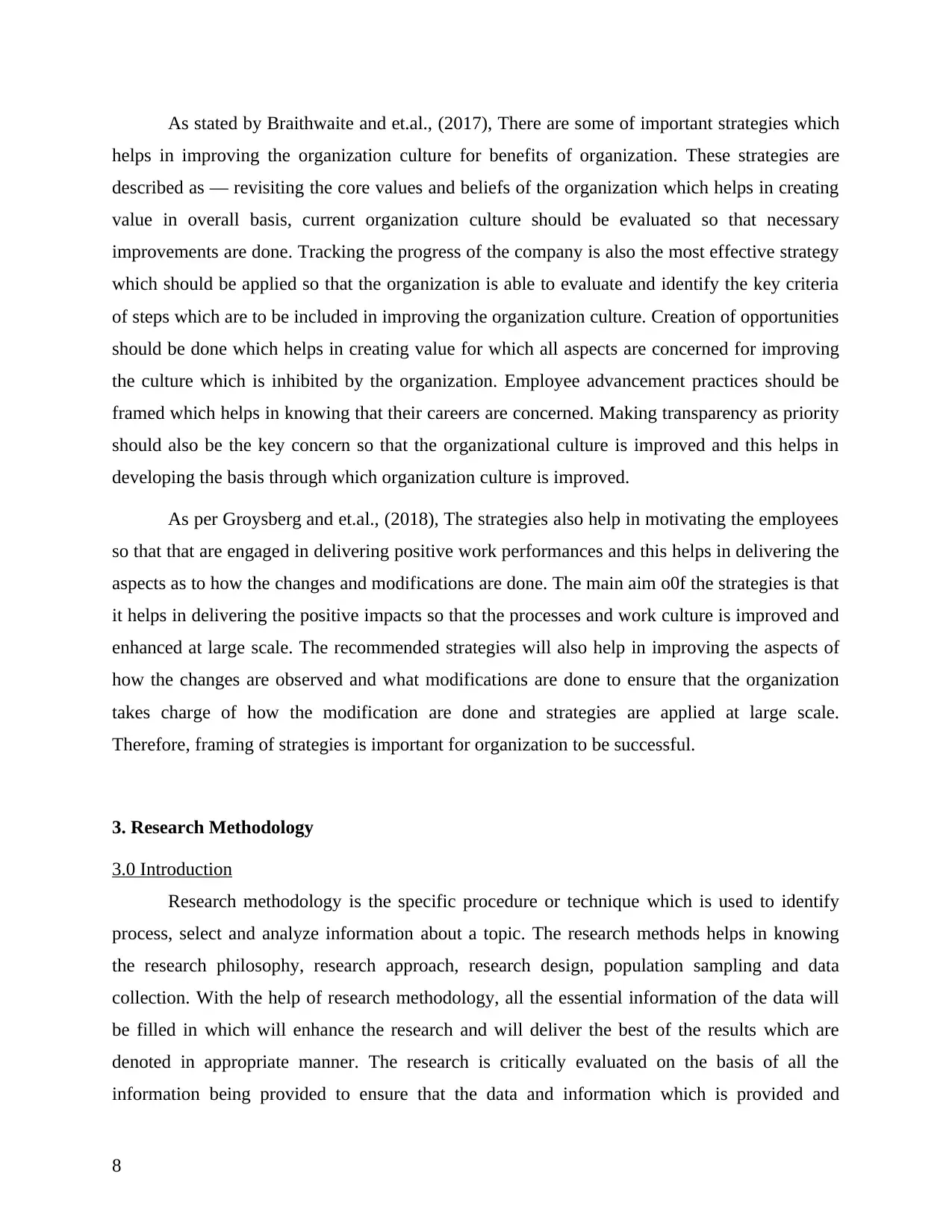
As stated by Braithwaite and et.al., (2017), There are some of important strategies which
helps in improving the organization culture for benefits of organization. These strategies are
described as — revisiting the core values and beliefs of the organization which helps in creating
value in overall basis, current organization culture should be evaluated so that necessary
improvements are done. Tracking the progress of the company is also the most effective strategy
which should be applied so that the organization is able to evaluate and identify the key criteria
of steps which are to be included in improving the organization culture. Creation of opportunities
should be done which helps in creating value for which all aspects are concerned for improving
the culture which is inhibited by the organization. Employee advancement practices should be
framed which helps in knowing that their careers are concerned. Making transparency as priority
should also be the key concern so that the organizational culture is improved and this helps in
developing the basis through which organization culture is improved.
As per Groysberg and et.al., (2018), The strategies also help in motivating the employees
so that that are engaged in delivering positive work performances and this helps in delivering the
aspects as to how the changes and modifications are done. The main aim o0f the strategies is that
it helps in delivering the positive impacts so that the processes and work culture is improved and
enhanced at large scale. The recommended strategies will also help in improving the aspects of
how the changes are observed and what modifications are done to ensure that the organization
takes charge of how the modification are done and strategies are applied at large scale.
Therefore, framing of strategies is important for organization to be successful.
3. Research Methodology
3.0 Introduction
Research methodology is the specific procedure or technique which is used to identify
process, select and analyze information about a topic. The research methods helps in knowing
the research philosophy, research approach, research design, population sampling and data
collection. With the help of research methodology, all the essential information of the data will
be filled in which will enhance the research and will deliver the best of the results which are
denoted in appropriate manner. The research is critically evaluated on the basis of all the
information being provided to ensure that the data and information which is provided and
8
helps in improving the organization culture for benefits of organization. These strategies are
described as — revisiting the core values and beliefs of the organization which helps in creating
value in overall basis, current organization culture should be evaluated so that necessary
improvements are done. Tracking the progress of the company is also the most effective strategy
which should be applied so that the organization is able to evaluate and identify the key criteria
of steps which are to be included in improving the organization culture. Creation of opportunities
should be done which helps in creating value for which all aspects are concerned for improving
the culture which is inhibited by the organization. Employee advancement practices should be
framed which helps in knowing that their careers are concerned. Making transparency as priority
should also be the key concern so that the organizational culture is improved and this helps in
developing the basis through which organization culture is improved.
As per Groysberg and et.al., (2018), The strategies also help in motivating the employees
so that that are engaged in delivering positive work performances and this helps in delivering the
aspects as to how the changes and modifications are done. The main aim o0f the strategies is that
it helps in delivering the positive impacts so that the processes and work culture is improved and
enhanced at large scale. The recommended strategies will also help in improving the aspects of
how the changes are observed and what modifications are done to ensure that the organization
takes charge of how the modification are done and strategies are applied at large scale.
Therefore, framing of strategies is important for organization to be successful.
3. Research Methodology
3.0 Introduction
Research methodology is the specific procedure or technique which is used to identify
process, select and analyze information about a topic. The research methods helps in knowing
the research philosophy, research approach, research design, population sampling and data
collection. With the help of research methodology, all the essential information of the data will
be filled in which will enhance the research and will deliver the best of the results which are
denoted in appropriate manner. The research is critically evaluated on the basis of all the
information being provided to ensure that the data and information which is provided and
8
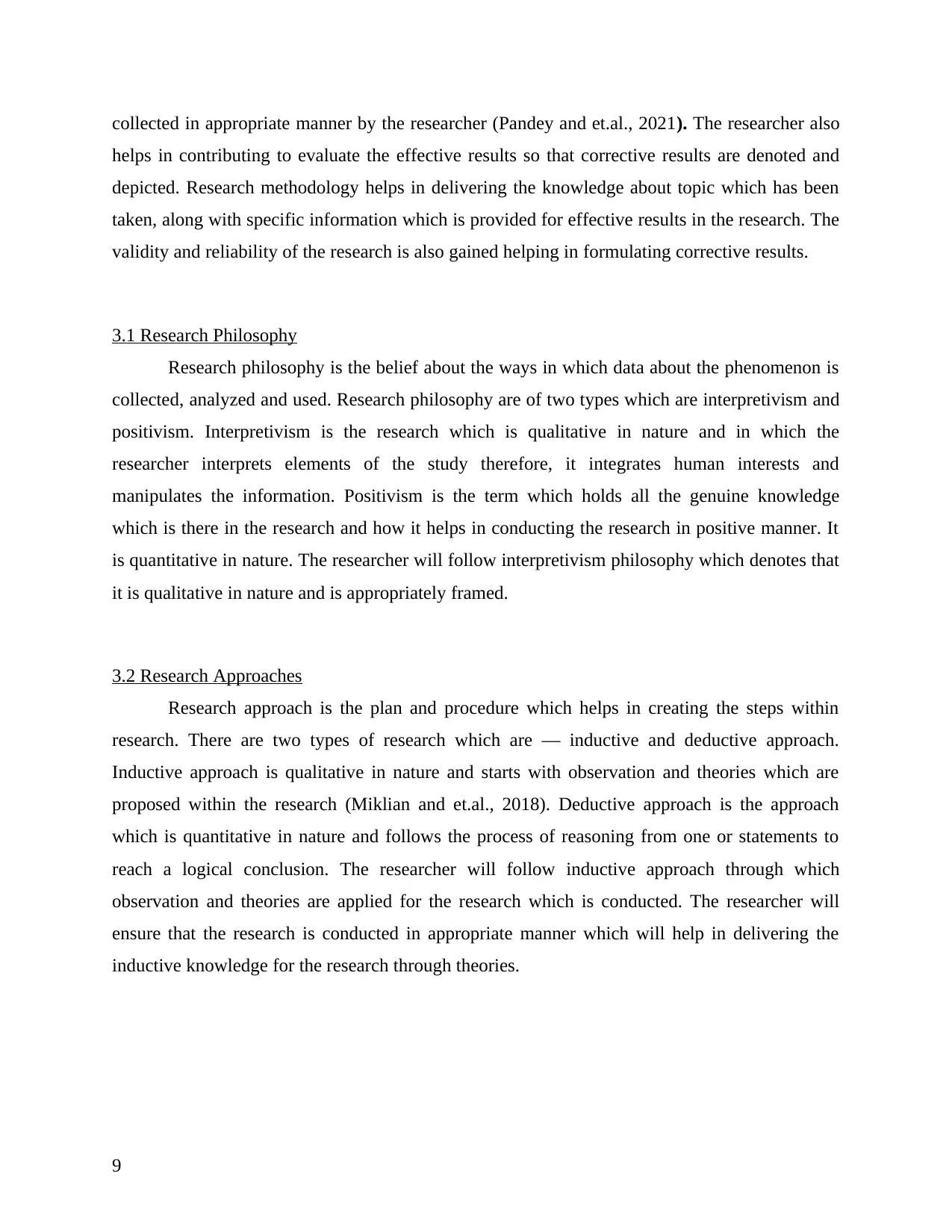
collected in appropriate manner by the researcher (Pandey and et.al., 2021). The researcher also
helps in contributing to evaluate the effective results so that corrective results are denoted and
depicted. Research methodology helps in delivering the knowledge about topic which has been
taken, along with specific information which is provided for effective results in the research. The
validity and reliability of the research is also gained helping in formulating corrective results.
3.1 Research Philosophy
Research philosophy is the belief about the ways in which data about the phenomenon is
collected, analyzed and used. Research philosophy are of two types which are interpretivism and
positivism. Interpretivism is the research which is qualitative in nature and in which the
researcher interprets elements of the study therefore, it integrates human interests and
manipulates the information. Positivism is the term which holds all the genuine knowledge
which is there in the research and how it helps in conducting the research in positive manner. It
is quantitative in nature. The researcher will follow interpretivism philosophy which denotes that
it is qualitative in nature and is appropriately framed.
3.2 Research Approaches
Research approach is the plan and procedure which helps in creating the steps within
research. There are two types of research which are — inductive and deductive approach.
Inductive approach is qualitative in nature and starts with observation and theories which are
proposed within the research (Miklian and et.al., 2018). Deductive approach is the approach
which is quantitative in nature and follows the process of reasoning from one or statements to
reach a logical conclusion. The researcher will follow inductive approach through which
observation and theories are applied for the research which is conducted. The researcher will
ensure that the research is conducted in appropriate manner which will help in delivering the
inductive knowledge for the research through theories.
9
helps in contributing to evaluate the effective results so that corrective results are denoted and
depicted. Research methodology helps in delivering the knowledge about topic which has been
taken, along with specific information which is provided for effective results in the research. The
validity and reliability of the research is also gained helping in formulating corrective results.
3.1 Research Philosophy
Research philosophy is the belief about the ways in which data about the phenomenon is
collected, analyzed and used. Research philosophy are of two types which are interpretivism and
positivism. Interpretivism is the research which is qualitative in nature and in which the
researcher interprets elements of the study therefore, it integrates human interests and
manipulates the information. Positivism is the term which holds all the genuine knowledge
which is there in the research and how it helps in conducting the research in positive manner. It
is quantitative in nature. The researcher will follow interpretivism philosophy which denotes that
it is qualitative in nature and is appropriately framed.
3.2 Research Approaches
Research approach is the plan and procedure which helps in creating the steps within
research. There are two types of research which are — inductive and deductive approach.
Inductive approach is qualitative in nature and starts with observation and theories which are
proposed within the research (Miklian and et.al., 2018). Deductive approach is the approach
which is quantitative in nature and follows the process of reasoning from one or statements to
reach a logical conclusion. The researcher will follow inductive approach through which
observation and theories are applied for the research which is conducted. The researcher will
ensure that the research is conducted in appropriate manner which will help in delivering the
inductive knowledge for the research through theories.
9
⊘ This is a preview!⊘
Do you want full access?
Subscribe today to unlock all pages.

Trusted by 1+ million students worldwide
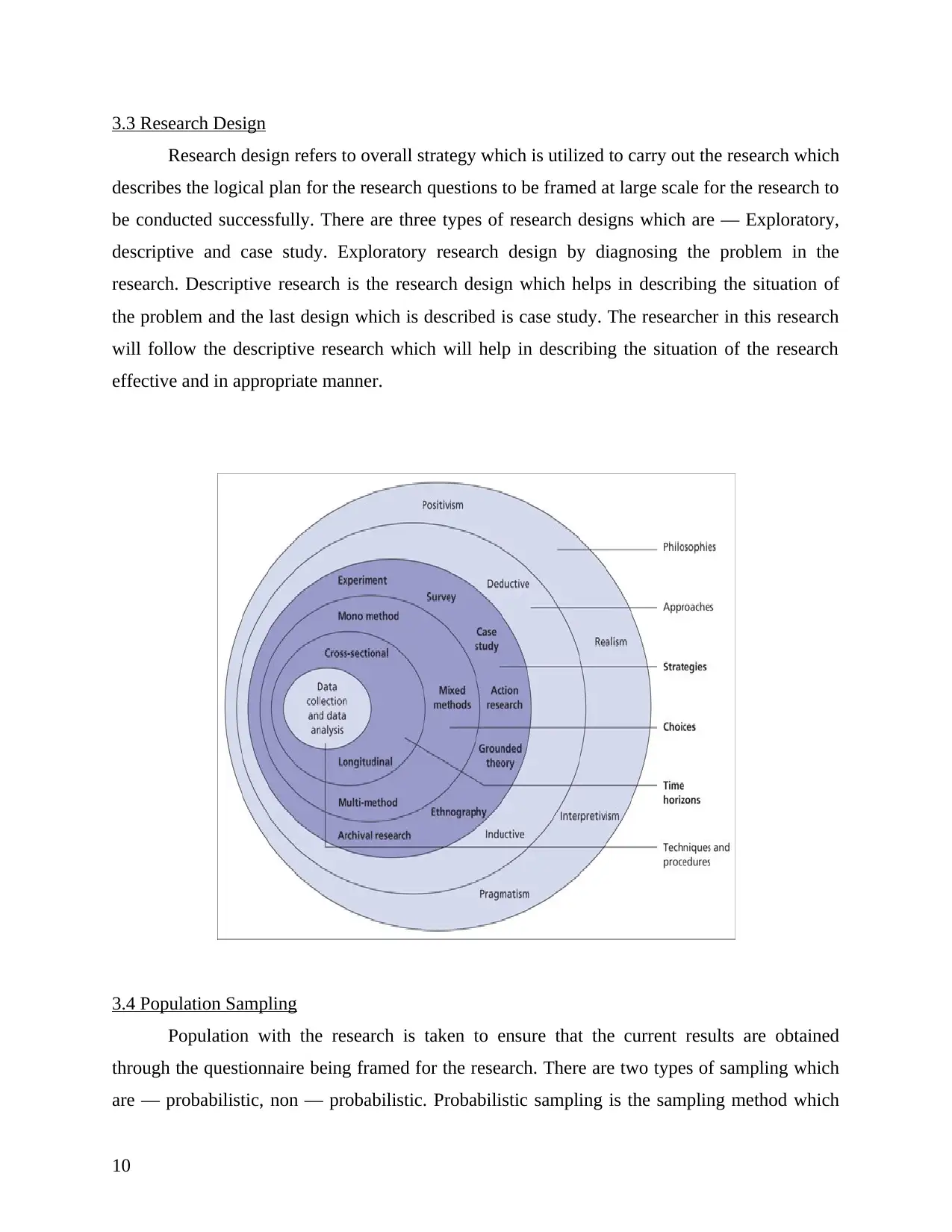
3.3 Research Design
Research design refers to overall strategy which is utilized to carry out the research which
describes the logical plan for the research questions to be framed at large scale for the research to
be conducted successfully. There are three types of research designs which are — Exploratory,
descriptive and case study. Exploratory research design by diagnosing the problem in the
research. Descriptive research is the research design which helps in describing the situation of
the problem and the last design which is described is case study. The researcher in this research
will follow the descriptive research which will help in describing the situation of the research
effective and in appropriate manner.
3.4 Population Sampling
Population with the research is taken to ensure that the current results are obtained
through the questionnaire being framed for the research. There are two types of sampling which
are — probabilistic, non — probabilistic. Probabilistic sampling is the sampling method which
10
Research design refers to overall strategy which is utilized to carry out the research which
describes the logical plan for the research questions to be framed at large scale for the research to
be conducted successfully. There are three types of research designs which are — Exploratory,
descriptive and case study. Exploratory research design by diagnosing the problem in the
research. Descriptive research is the research design which helps in describing the situation of
the problem and the last design which is described is case study. The researcher in this research
will follow the descriptive research which will help in describing the situation of the research
effective and in appropriate manner.
3.4 Population Sampling
Population with the research is taken to ensure that the current results are obtained
through the questionnaire being framed for the research. There are two types of sampling which
are — probabilistic, non — probabilistic. Probabilistic sampling is the sampling method which
10
Paraphrase This Document
Need a fresh take? Get an instant paraphrase of this document with our AI Paraphraser
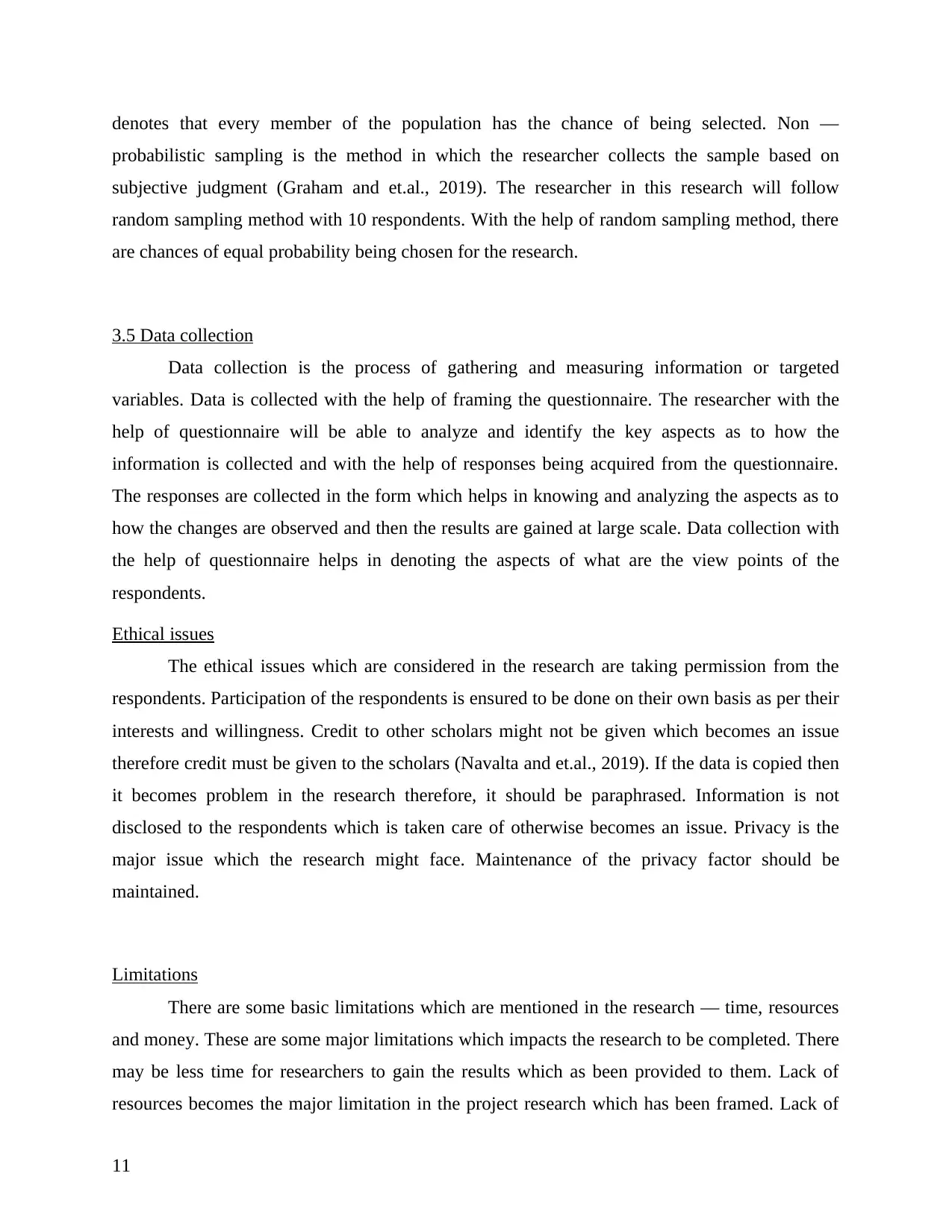
denotes that every member of the population has the chance of being selected. Non —
probabilistic sampling is the method in which the researcher collects the sample based on
subjective judgment (Graham and et.al., 2019). The researcher in this research will follow
random sampling method with 10 respondents. With the help of random sampling method, there
are chances of equal probability being chosen for the research.
3.5 Data collection
Data collection is the process of gathering and measuring information or targeted
variables. Data is collected with the help of framing the questionnaire. The researcher with the
help of questionnaire will be able to analyze and identify the key aspects as to how the
information is collected and with the help of responses being acquired from the questionnaire.
The responses are collected in the form which helps in knowing and analyzing the aspects as to
how the changes are observed and then the results are gained at large scale. Data collection with
the help of questionnaire helps in denoting the aspects of what are the view points of the
respondents.
Ethical issues
The ethical issues which are considered in the research are taking permission from the
respondents. Participation of the respondents is ensured to be done on their own basis as per their
interests and willingness. Credit to other scholars might not be given which becomes an issue
therefore credit must be given to the scholars (Navalta and et.al., 2019). If the data is copied then
it becomes problem in the research therefore, it should be paraphrased. Information is not
disclosed to the respondents which is taken care of otherwise becomes an issue. Privacy is the
major issue which the research might face. Maintenance of the privacy factor should be
maintained.
Limitations
There are some basic limitations which are mentioned in the research — time, resources
and money. These are some major limitations which impacts the research to be completed. There
may be less time for researchers to gain the results which as been provided to them. Lack of
resources becomes the major limitation in the project research which has been framed. Lack of
11
probabilistic sampling is the method in which the researcher collects the sample based on
subjective judgment (Graham and et.al., 2019). The researcher in this research will follow
random sampling method with 10 respondents. With the help of random sampling method, there
are chances of equal probability being chosen for the research.
3.5 Data collection
Data collection is the process of gathering and measuring information or targeted
variables. Data is collected with the help of framing the questionnaire. The researcher with the
help of questionnaire will be able to analyze and identify the key aspects as to how the
information is collected and with the help of responses being acquired from the questionnaire.
The responses are collected in the form which helps in knowing and analyzing the aspects as to
how the changes are observed and then the results are gained at large scale. Data collection with
the help of questionnaire helps in denoting the aspects of what are the view points of the
respondents.
Ethical issues
The ethical issues which are considered in the research are taking permission from the
respondents. Participation of the respondents is ensured to be done on their own basis as per their
interests and willingness. Credit to other scholars might not be given which becomes an issue
therefore credit must be given to the scholars (Navalta and et.al., 2019). If the data is copied then
it becomes problem in the research therefore, it should be paraphrased. Information is not
disclosed to the respondents which is taken care of otherwise becomes an issue. Privacy is the
major issue which the research might face. Maintenance of the privacy factor should be
maintained.
Limitations
There are some basic limitations which are mentioned in the research — time, resources
and money. These are some major limitations which impacts the research to be completed. There
may be less time for researchers to gain the results which as been provided to them. Lack of
resources becomes the major limitation in the project research which has been framed. Lack of
11
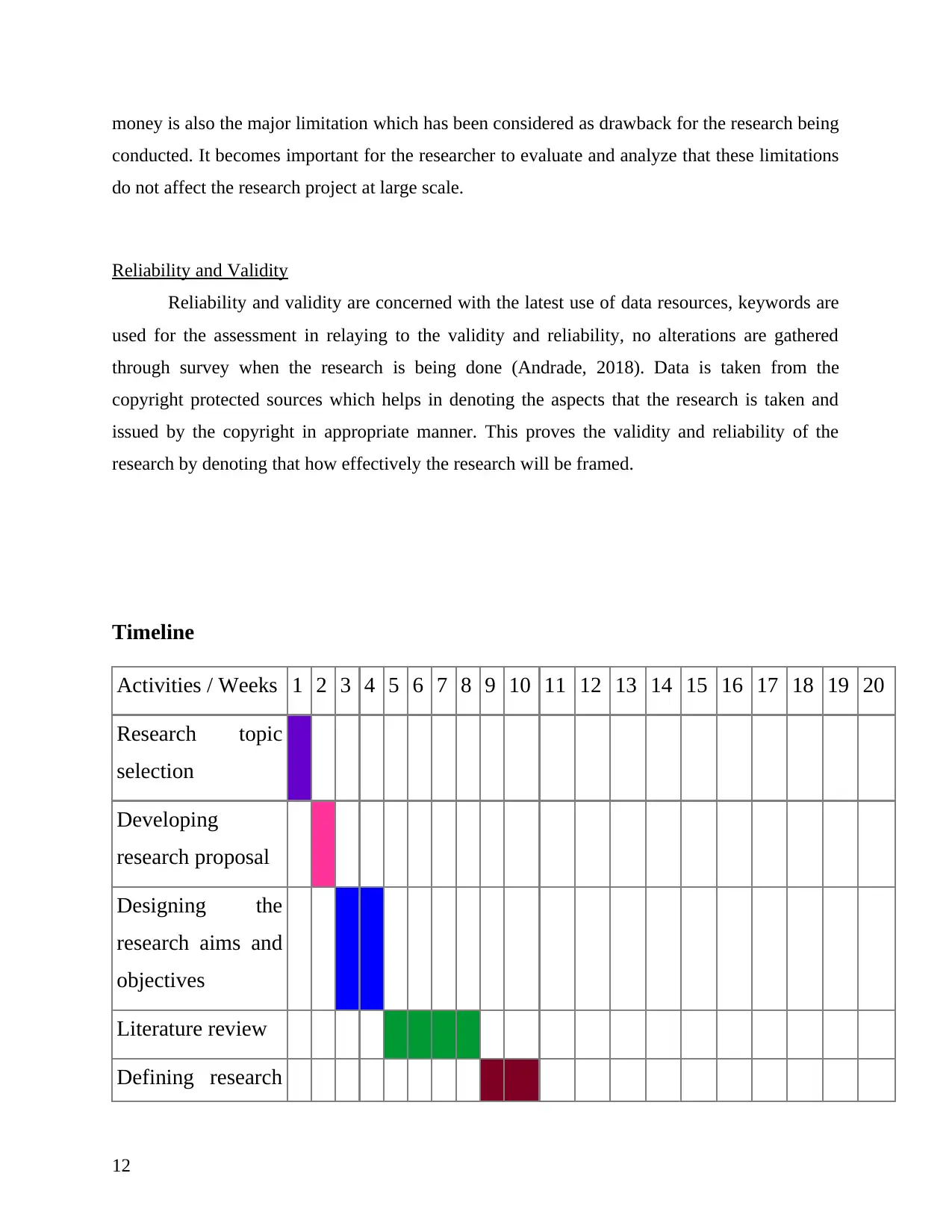
money is also the major limitation which has been considered as drawback for the research being
conducted. It becomes important for the researcher to evaluate and analyze that these limitations
do not affect the research project at large scale.
Reliability and Validity
Reliability and validity are concerned with the latest use of data resources, keywords are
used for the assessment in relaying to the validity and reliability, no alterations are gathered
through survey when the research is being done (Andrade, 2018). Data is taken from the
copyright protected sources which helps in denoting the aspects that the research is taken and
issued by the copyright in appropriate manner. This proves the validity and reliability of the
research by denoting that how effectively the research will be framed.
Timeline
Activities / Weeks 1 2 3 4 5 6 7 8 9 10 11 12 13 14 15 16 17 18 19 20
Research topic
selection
Developing
research proposal
Designing the
research aims and
objectives
Literature review
Defining research
12
conducted. It becomes important for the researcher to evaluate and analyze that these limitations
do not affect the research project at large scale.
Reliability and Validity
Reliability and validity are concerned with the latest use of data resources, keywords are
used for the assessment in relaying to the validity and reliability, no alterations are gathered
through survey when the research is being done (Andrade, 2018). Data is taken from the
copyright protected sources which helps in denoting the aspects that the research is taken and
issued by the copyright in appropriate manner. This proves the validity and reliability of the
research by denoting that how effectively the research will be framed.
Timeline
Activities / Weeks 1 2 3 4 5 6 7 8 9 10 11 12 13 14 15 16 17 18 19 20
Research topic
selection
Developing
research proposal
Designing the
research aims and
objectives
Literature review
Defining research
12
⊘ This is a preview!⊘
Do you want full access?
Subscribe today to unlock all pages.

Trusted by 1+ million students worldwide
1 out of 15
Related Documents
Your All-in-One AI-Powered Toolkit for Academic Success.
+13062052269
info@desklib.com
Available 24*7 on WhatsApp / Email
![[object Object]](/_next/static/media/star-bottom.7253800d.svg)
Unlock your academic potential
Copyright © 2020–2025 A2Z Services. All Rights Reserved. Developed and managed by ZUCOL.





